Bangladesh Genocide Archive
An online archive of chronology of events, documentations, audio, video, images, media reports and eyewitness accounts of the 1971 Genocide in Bangladesh in the hands of Pakistan army.Refugees
http://www.genocidebangladesh.org/?page_id=39Escaping from the Genocide:
1971 witnessed worst human influx from Bangladesh to neighboring India. Indian government reports that around 8-9 million migrants took shelter in 829 refugee camps. According to National Geographic (Sept. 1972), the estimated number of Bangladeshi refugees was 10.0 million. Also, a large number of people were displaced within the country, estimated number was around 20 million (The UN in Bangladesh). To escape mass killing, rape and destruction, men, women and children defied many odds that took toll of untold sufferings and death. Then youth from all over the country crossed border to take arms training and join resistance as Mukti Bahini (Freedom Fighters).
Such a colossal influx had naturally been a huge burden on Indian economy and took India few months to give refugees logistic support in make shift refugee camps. In Eastern province of Tripura, refugees outnumbered local inhabitants. In initial period, some refugees had to take shelter in subhuman conditions in abandoned drainage pipes at Salt Lake, Calcutta.
Over crowded improvised living conditions in refugee camps lead to sickness and death. Beside government support, local people and some aid agencies helped to mitigate this sufferings.
Demography of the refugees: The US Department of State gave wrong information when it says that most of the refugees in India were mostly Hindus. The percentages of the religions there represented the percentages in the national population as per official records.
Letter from Indian Prime Minister Gandhi to President Nixon:
"Until the 12th May, 1971, the number of fugitives who were registered on their crossing the border into India was 2,328,507. We believe that there is a fair number who have avoided registration. Refugees still continue to pour in at the rate of about fifty thousand a day."
By the end of May 1971 the number rose to 3 million.
Bengali refugees heading to India to flee persecution during the 1971 war of liberation
(Image credit: tovarish_udn from Flickr)
Letter from President Yahya to President Nixon on May 24:
"It is most unfortunate that due to disturbed conditions and for other reasons, a large number of people left their homes in East Pakistan and crossed into India. I have, therefore, in a public statement urged the law abiding citizens of East Pakistan who were compelled to migrate, to return to their homes and resume their normal duties. I am afraid, however, that I cannot extend a welcome to those persons who committed murders, indulged in rape and arson, destroyed private and public properties and looted Government treasuries and food stores. No Government can condone such crimes against the people and the State."
However he conceals the cause of these mass exodus which is evident in this Guardian (London) report:
"The total picture of what has been happening in East Bengal is clear to us without any shadow of doubt. There are scores of survivors of firing-squad line-ups. Hundreds of witnesses to the machine-gunning of political leaders, prefessors, doctors, teachers and students. Villages have been surrounded, at any time of day or night, and the frightened villagers have fled where they could, or been slaughtered where they have been found. or enticed out to the fields and mown down in heaps. Women have been raped, girls carried off to barracks, unarmed peasants battered or bayoneted by the thousands.
About 400 were killed at Chaudanga while on their way to India, surrounded and massacred. Why? Lest they take tales to India? Or because choosing a certain democratic system under Sheikh Mujib means forfeiting the right to live in any country?"
Telegram from the US embassy in India to the US Department of State on June 11, 1971:
"The number of refugees is now 5.4 million and that rate of flow is increasing. This should be evidence enough that no matter what noises President Yahya may make about restoration of normalcy, he has not yet done anything to effectively impede reign of terror and brutality of Pakistan army, the root cause of the refugee exodus."
US embassy in Pakistan refuted Yahya's claim that Indian's are preventing refugees to go back to East Pakistan:
"Kellogg repeated that none of Indian officials with whom he had spoken had said they wanted refugees to remain; nor had any referred to desire to see independent East Pakistan; "Bangla Desh" was never once mentioned to him. Meanwhile, if persons were continuing to leave East Pakistan and not returning in any appreciable numbers, Kellogg said, it would appear that they continued to be motivated by fear which caused them to flee in first place."
The US Consulate General in Dacca warned in July 1971 that unless steps were taken to prevent famine in East Pakistan anticipated deaths from mass starvation could approach the catastrophe of the Bengal famine of 1943 in which millions of people died.
A report of the Canadian parliamentary delegation on July 19 confirms that the number of refugees are from 6.4 million to 6.8 million. They stressed the humanitarian conditions of the refugees and suggested actions.
"Escape from terror": a report of the International Rescue Committee's Emergency Mission to India for Pakistan refugees.
"Preoccupied with the basic needs of refugees, i.e., food, shelter and first-aid, the (Indian) governmental assistance program, though substantial, cannot cope with the multi – faceted organizational and financial needs described in the foregoing pages. Nor can it be expected to take care of relief payments to the substantial number of artists, writers, journalists, scientists and similar categories of refugees who have found asylum in India. They have depended thus far on the help of their Indian colleagues. Some of them face starvation."
New York Times, July 4, 1971.
State/District…. In Reception Ctrs | With friends/relatives
Assam…. 81,800 | 65,677
Tripura…. 381,373 | 363,464
Meghalaya…. 186,052 | 49,332
West Bengal.
Nadia .. .. .. .. 214,788 | 170,951
24-Parganas … .. 503,467 | 179,250
Maurshidabad .. .. 134,507 | 51,953
West Dinajpur … .. 783,664 | 511,555
Jalpaiguri .. .. .. . 140,402 | 165,000
Cooch-Behar .. .. ..189,755 | 210,875
Malda .. .. 92,139 | 254,513
————- | ————
2,707,947 | 2,022,570
By June 15, the number of refugees had gone up to 5.8 million, of whom 3.7 million were living in camps. With the outbreak of cholera in early June, news of which spread into East Pakistan, the border crossings did slow down. Yet once the cholera threat subsided, thousands again began to pour over every night, despite the desperate air of tension the Pakistani Army has tried to maintain along the border by mortar fire to which the Mission can bear personal witness. There is no indication that the exodus has been halted. If the present trend continues, the figure is likely to go to seven million before July is out. Seven million people is the total population of Cuba.
A report of the Canadian parliamentary delegation on July 19 confirms that the number of refugees are from 6.4 million to 6.8 million. They stressed the humanitarian conditions of the refugees and suggested actions.
A July 23 press report, quoting the West Bengal Health Services Director, warned that 300,000 refugee children were on the verge of death from starvation. (Source)
On August 2 an US internal assessment of the situation states:
"Persecution of Hindus declining in direct proportion to decline in size Hindu population. Latest estimate puts six million East Pakistan Hindus in India. Hindu monuments being destroyed some areas. Such destruction observed in Dacca and Chittagong and Hindu sculpture now very easy to obtain. Some Dacca streets with Hindu and English names renamed with Muslim names."
The refugee flow to India continues. This has increased to a rate of some 50,000 per day after a drop in late July. This could be a temporary aberration; it could result from a new increase in violence; or it could reflect hunger in some pockets. Just maintaining the present number of refugees is projected to cost (Indians) $600 million in a year, a figure larger than the net flow of foreign aid from consortium donors. (An August brief of Kissinger to Nixon)
The refugee flow has continued at a ratio of 15,000 to 40,000 a day over the past two months, according to Indian figures. Probably close to 7.5 million of the total of 8.76 million refugees are Hindus, meaning that roughly three-quarters of the Hindu population of East Pakistan has left. (Situation report in September: US Dept of State)
Extracts from Prime Minister Indira Gandhi's address at the Moscow University:
"We were about to embark upon a new programme of economic advance, when from across our frontiers we had a new kind of invasion: not of armed men, but of a vast influx of helpless terror-stricken men, women and children from East Bengal-some wounded, some ill and all hungry. More than 9 million people have come in the last six months, and they continue to pour in. Has there been a greater migration in history?
Statement by Shri G.S. Kahlon, Rehabilitation Secretary, Government of India In the 22nd session of the executive committee of UNHCR held in Geneva:
"Beginning from end of March, within a couple of months total influx of refugees into India had gone up to nearly four million, and today it has crossed 9 million already, without any signs of them returning to East Pakistan at all. Average inflow per day still continues to be between 30,000 to 50,000 persons, and if this rate continues at this scale we may well have not less than 12 million refugees on our hands by end of this year.
The Government of India has made provision of Rs. 260 crores (US dollars 360 million) for all this relief work up to end of December, 1971. This includes expected amount of Rs. 50 crores (US dollars 69 million) in foreign aid. However, now for 8 million refugees in camps (which, it is considered, will be the figure shortly because of increased inflow, as well as demand of those who had come to friends and relatives to be helped by Government now) it is estimated that for a period of six months we would require Rs. 419 crores or US dollars 558 million Grand total is Rs. 4,187.89 million or say Rs. 4,188 million. This is equivalent to 558 million US dollars.
For feeding refugees, Government of India have fixed scales of rations for adults and children according to advice of its nutritional experts. Thus, every adult gets 300 grams of rice, 100 grams of wheat flour, 100 grams of pulses, 25 grams of edible oil and 25 grams of sugar per head per day; and every child between the age of 1 year and 8 years gets 150 grams of rice, 50 grams of wheat flour, 50 grams of pulses, 12 grams of edible oil and 15 grams of sugar per head per day. Apart from this, a small amount is also provided for each refugee in cash per head per day for the purpose of buying vegetables, spices, fuel, washing soap, etc. Similarly, for clothes, deserving people in camps are being given these-cotton or woollen."
(Image credit: tovarish_udn from Flickr)
Consequent on the liberation of BanglaDesh, the influx of refugees from East Bengal had ceased. After December 16, 1971, with the liberation of Dacca, the return of refugees gained momentum and a large number of refugees started returning at their own initiative. Shortly afterwards, planned movement of refugees, under Government arrangements, took place.
The last batch of 3,869 refugees in camps left for Bangla Desh on March 25, 1972, exactly after one year of the Pakistan army crack down on Bangla Desh people. With the return of these refugees, all the Central and State refugee camps have now been closed. About 60,000 refugees staying with their relatives will go back on their own.
Since March 25, 1971, 9,899,305 refugees had sought refuge in India. Click on this link for the tables which give an idea of the magnitude of the problem that India had to face.
Name of State Total Influx.
————– ———–
West Bengal … 7,493,474
Tripura … 1,416,491
Meghalaya … 667,986
Assam … 312,713
Bihar … 8,641
———
Total … 9,899,305
=======
Return of Refugees
Articles:
* Refugee Exodus Planned – St. Petersburg Times, Dec 24, 1971
* Millions return to Bangladesh – The Bryan Times, January 12, 1972
The Biharis in Bangladesh:
"Because east Bengal was expected to become Pakistan, many people from Bihar had fled to settle there after the Bihar massacre. The Biharis identified themselves more with the West Pakistanis than the Bengalis, and both spoke Urdu. They made little attempt to assimilate with the local populace. So a distance between the two communities developed which became gradually wider."
Citizens of Nowhere: Who Are the Biharis and Why Are They Forgotten:
Originally from India's Bihar State, the Urdu-speaking Biharis moved to then East Pakistan in 1947, at the time of India's partition. When East Pakistan moved to secede and civil war broke out between East and West Pakistan in 1971, the Biharis, who considered themselves citizens of Pakistan, sided with West Pakistan. During the liberation war of Bangladesh there were many attacks on the Bihari community as they helped Pakistani Army and conspired against the Bengali population.
During the war several places in Dhaka city were strongholds of Biharis especially the Mirpur area which is known for a famous mass murder site known as the Jalladkhana (butchers' den). A survivor tells:
The same Biharis who had been our neighbours for years brought the military to my house. They took my husband and his elder brother. A few hours later we heard the news that they were brutally killed with bayonets inside the Jalladkhana.
In January 1972, Bangladeshi troops were ordered to confiscate all weapons, but they met fierce resistance when they approached the Bihari enclave of Mirpur. Almost 100 people on either side of the conflict were killed and following the incident, several thousands of Biharis were arrested and imprisoned on allegations of collaboration. Mirpur was liberated on January 31, 1972, one and a half months after the victory on December 16, 1971. (The Daily Star)
After the defeat of the Pakistani forces, Bangladeshi nationalist forces, most notoriously the Kader Bahini militia led by Abdul Kader Siddique, exacted revenge on those who had been viewed as 'collaborators' of the Pakistani forces. In particular, Biharis, some of whom had formed Razakars and Al Shams Islamist militias in support of the Pakistani Army, were subjected to massive reprisal attacks. (Wikipedia)
Foreign newspaper reports of attacks of revenge by mobs
Pakistan feared a mass influx of Biharis would be costly and could potentially stir passions in an already fragmented population. Newly formed Bangladesh scorned the Biharis for having supported the enemy. Neither country offered citizenship or aid. While Bangladesh permitted Biharis to stay, and they received some assistance from international organizations such as the International Committee of the Red Cross in the early days, they have now lived in refugee-like camps in Bangladesh for more than three decades with little attention from the global community. Their lack of political voice further prevents any movement toward improvement in the situation. Nevertheless, some Biharis have organized, forming organizations such as the Stranded Pakistani General Repatriation Committee, and began lobbying for relocation to Pakistan.
Although Biharis were among those accepted by Pakistan under the August 1973 repatriation accord, Pakistan was slow in giving clearances. At a meeting of the foreign ministers of the three countries in New Delhi in April 1974, a new tripartite agreement on a second phase of repatriation was reached. More than 170,000 Biharis moved to Pakistan under the terms of these agreements. But Pakistan interpreted the categories of 'non-Bengalis' set out in the agreement restrictively and did not take back all Biharis. In addition to this earlier movement, nearly 9,900 Biharis repatriated to Pakistan between 1977 and 1979 and further, 4,800 more of them in 1982. In 1993, Pakistan accepted 53 more Bihari families but then the process stopped. (Banglapedia)
In 1999, over 200,000 Biharis were still living in 66 camps of Bangladesh with poor facilities. Two generations of Biharis now live in camps. For some members of the younger generation, Bangladesh is the only home they have ever known, and Bengali is the language they have learned.
In the spring of 2003, a high court ruling in Bangladesh allowed ten Biharis to assume Bangladeshi citizenship with voting rights. The judgment stated that Urdu-speaking people, who were resident at the time of independence, as well as those born following independence and living in camps, are citizens of Bangladesh in the application of the 1972 Bangladesh Citizenship Order.
In September 5, 2007 an inter-ministerial decision by the Bangladeshi government which, pending legal review, would grant those Biharis or Urdu-speaking people born after the time of independence in Bangladesh and who wish to become citizens, the right to be registered as voters and to receive national identity cards.
In May 2008 the Dhaka high court ruled that some 150,000 Urdu-speaking Muslim refugees have the right to be Bangladesh citizens. The ruling applies to those who were minors when Bangladesh won independence in 1971 or born after. (BBC)
In Bangladesh they have not lived in captivity and had the chance to assimilate and make a normal living (many have done that) like any Bangladeshi national but they have chosen this hard camp life because they have kept their hopes alive that they can get back to Paksitan some day. However they feel deprived by their nation (Pakistan) for whom they have kept their allegiance for all these days.
Photo Set: Nowhere People: The Bihari – Greg Constantine
In 1971, there were about 1.5 million non-Bangalis living in East Pakistan. The West Pakistanis and Biharis enjoyed special privileges and when Sheikh Mujib declared war in 1971 for a free Bangladesh, the Biharis were in a dilemma. They had suffered through terrible communal riots in 1947 for the idea of the state of Pakistan, and they had antipathy and deep suspicion towards the state of India. Believing the Pakistan army's propaganda that Mujib was 'plotting with the Indians to break up Pakistan', their sympathies naturally went against the Bangali liberation war. The Pakistan army exploited this weakness to recruit Biharis to join the Rajakar death squads. Not all Biharis joined, but those that did not remained silent spectators of the conflict. They did not join the refugees crossing the borders, or take up arms against the Army.
- A Place to Call Home – The Daily Star
Articles:
* The people that Paksitan forgot – Dr Ahmad Faruqui, Dansville, CA, USA
* Bangladesh's refugees dream of Pakistan -Julhas Alam
Source: Liberation War Museum, Virtual Bangladesh, Refugees International.
Image Courtesy: UNHCR, Bangladesh 1971
1 Response
--
Palash Biswas
Pl Read:
http://nandigramunited-banga.blogspot.com/

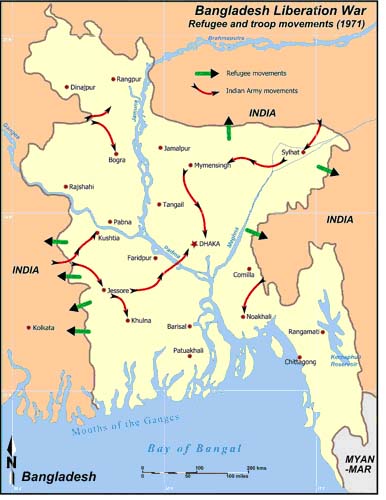
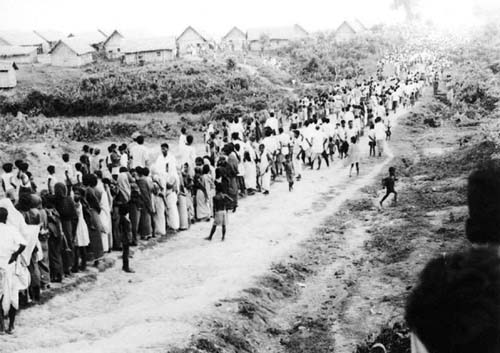
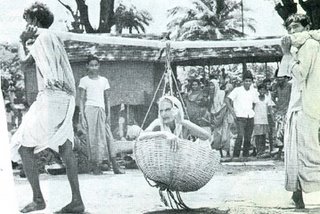
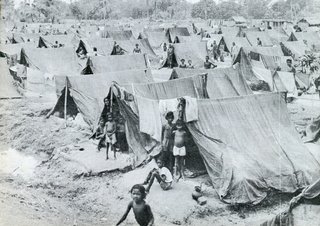
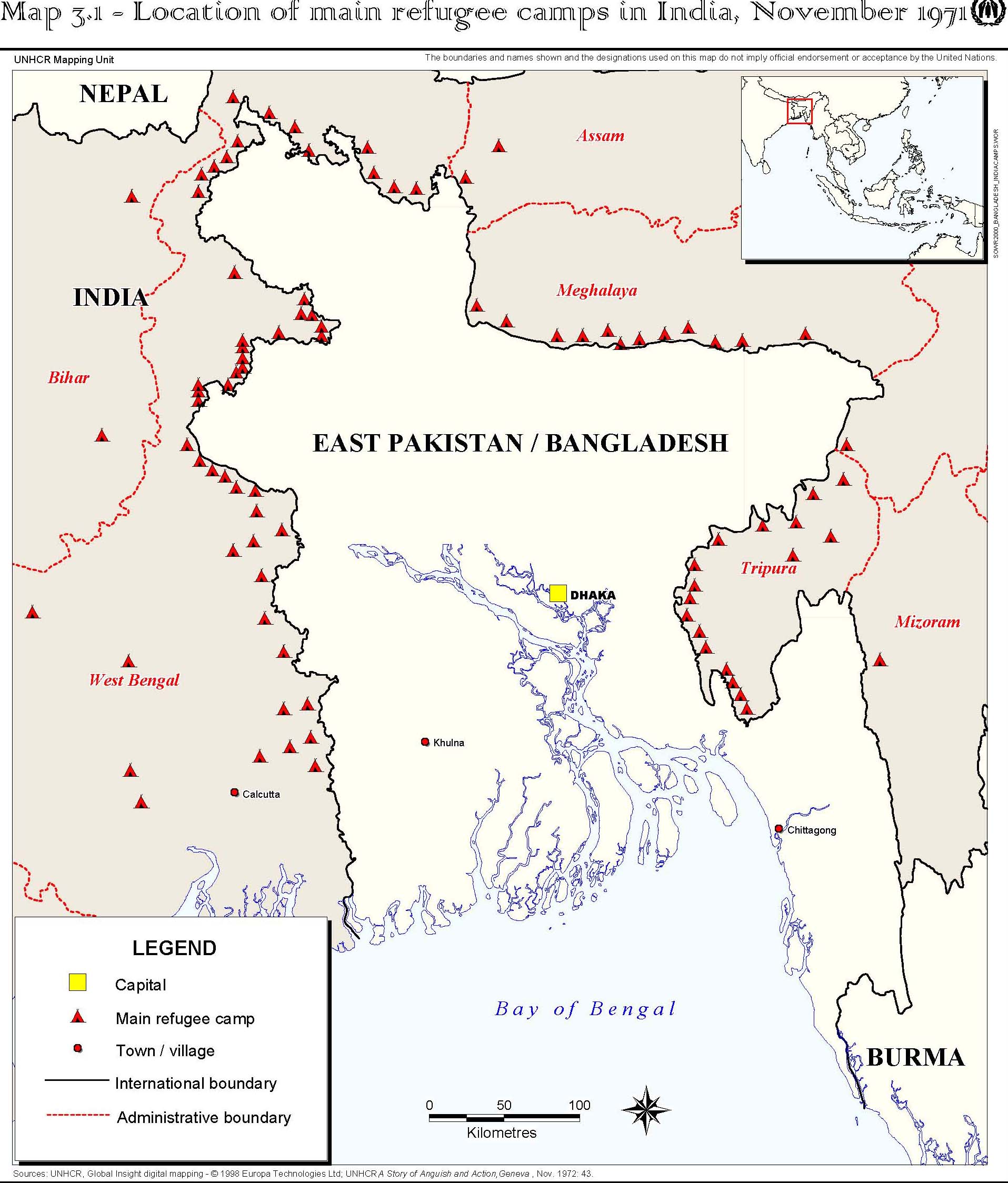
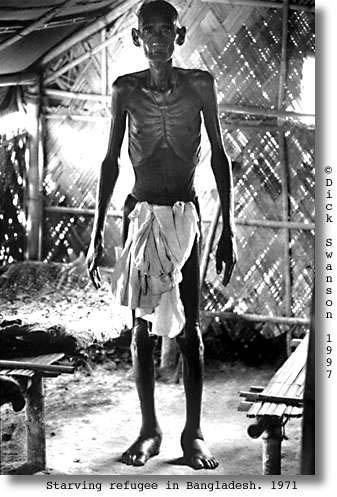
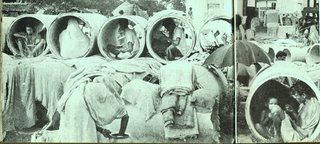




Global Voices Online » Bangladesh: Mourning Senator Edward Kennedy:
[...] and across the world for his legacy of fighting for the rights of the people in trouble, be it the Bangladeshi refugees during the liberation war, Ethiopian famine victims or being a catalyst to the peace process in [...]
Posted on August 27th, 2009 at 4:24 am